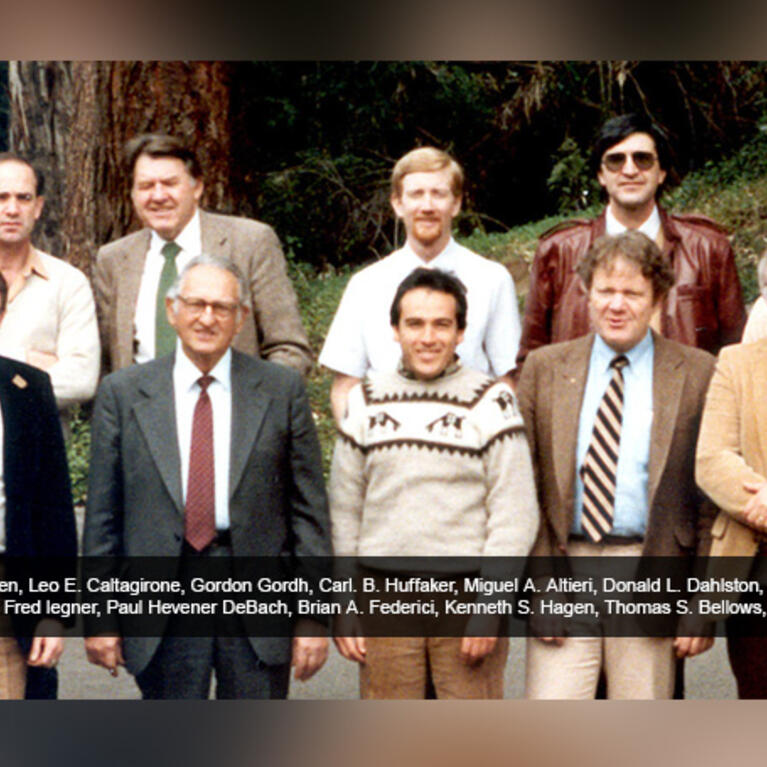Artificial Sweetener Could Be New Tool in Cockroach Management
ENTOMOLOGY TODAY - German cockroaches (Blattella germanica) are a major global insect pest in urban buildings as purveyors of allergens as well as pathogens such as Salmonella, E. coli, and Rotavirus. Control of German cockroaches is usually done with insecticide sprays and insecticide-loaded baits, but cockroach populations can evolve resistance to insecticides, and insecticides can...
By John P. Roche, Ph.D. | Entomology Today |

In Memoriam: Richard D. Goeden (1935-2023)
Richard Dean “Dick” Goeden, Professor Emeritus of Entomology, passed away on August 17, 2023. Goeden was born in Neillsville, Wisconsin on May 20, 1935, to Aleda and InJerome Goeden. He grew up in Wisconsin, but little is known about his childhood; he did at times recall that he played cards after school with his buddies...
Western U.S. has more subterranean termite species than previously thought, study shows
ENTOMOLOGY TODAY - Subterranean termites in the genus Reticulitermes are common pests in North America, responsible for significant damage to wooden structures. The scientific literature maintains that the western United States is home to two native species of termites: Reticulitermes hesperus in more coastal regions from British Columbia to Southern California, and Reticulitermes tibialis in...
By Andrew Porterfield | Entomology Today |
What are those web-like clumps falling from the sky around the Bay Area?
LOS ANGELES TIMES - In time for the Halloween festivities, residents in the Bay Area and Central California reported seeing clumps of web-like substances hanging from trees or drifting in the wind last week. The most likely sources of the spooky-looking webbing are baby spiders who use updraft winds to disperse themselves after hatching, according...
By Karen Garcia | LA Times |
UC Riverside’s new entomology garden is an outdoor classroom
THE PRESS-ENTERPRISE - UC Riverside entomology students have a new place to do their fieldwork — next door to the campus entomology museum. The Entomology Teaching Garden, which is open to the public, will serve as an “outdoor classroom and living laboratory for faculty and students,” a UCR news release states. The plant-filled garden is...
By Staff Report | The Press-Enterprise |
What is the deadliest spider in the world?
LIVE SCIENCE - Spiders are common critters. And, as almost all of Earth's 43,000 known spider species are venomous, it is likely that most people have encountered a venomous spider at one point or another. So that's the bad news. The good news, however, is that of these, only 25 species are known to have...
By Joshua A. Krisch | Live Science |
Finding Pheromones: How One Entomologist Puts Discoveries to Work in Pest Management
ENTOMOLOGY TODAY - Jacqueline Serrano, Ph.D., is a research entomologist at the U.S. Department of Agriculture’s Agricultural Research Service (USDA-ARS) in the Temperate Tree Fruit and Vegetable Research Unit, in Wapato, Washington. She earned her B.S. in biology (2012) and Ph.D. in entomology (2019) at the University of California, Riverside. She first joined USDA-ARS as...
By Emily Sandall, Ph.D. | Entomology Today |
UCCE researchers target sugar-feeding ants, a key to controlling citrus pests, disease
UNIVERSITY OF CALIFORNIA AGRICULTURE & NATURAL RESOURCES (UCANR) - Sugar-feeding ants protect pests that infect trees and damage the fruit they bear. Insecticides are often a go-to solution, but may kill beneficial insects in the process, too. Thankfully, Mark Hoddle, University of California Cooperative Extension entomologist and biological control specialist at UC Riverside, together with...
By Saoimanu Sope | UCANR |

WHO’S EATING WHO?
You never forget the moment when your path in life becomes clear. For Erin Wilson-Rankin, that moment came in an undergraduate classroom at Georgetown University when she learned about a caterpillar that evades predators by flinging its poop. “It was actually my professor, Martha Weiss, talking about her own research into the silver-spotted skipper butterfly...
By Jules Bernstein | UCR Magazine |
How you can help count and conserve native bees
NEW YORK TIMES - In the last 20 years, the rusty patched bumblebee population declined by 87 percent because of habitat loss, use of pesticides and disease. This fuzzy bee, native to the continental United States, gets its name from the rusty patch on its back. “While regional studies have tracked the decline of native...
By Michele C. Hollow | The New York Times |
Let us help you with your search